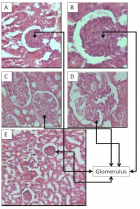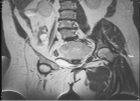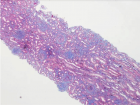Abstract
Research Article
Renal function effects of FDS, a saponin isolated from Filicium decipiens seeds: Biochemical and Histopathological studies
Romero MP Brandao-Costa*, Juanize Matias S Batistaa, Thiago Pajeu Nascimento and Ana LF Porto
Published: 31 October, 2019 | Volume 3 - Issue 3 | Pages: 107-110
Physicochemical and pharmacological studies indicated that Filicium decipiens seeds contained various specialized metabolites, including saponins. The aim of this work is to reveal the nephrotoxicity of FDS, a saponin isolated from Filicium decipiens seeds on male Wistar rats histopathological and biochemical parameters. Rats were submitted to oral ingestion of FDS (6.0 mg/kg) and crude extract (120.0 mg/kg) and were observed high levels of urea and creatinine in blood analyses of all animals followed by an acute renal failure by glomerular retraction. In the present study, FDS and crude extract when administered in Wistar rats induced an increase of serum levels of Urea and Creatinine, biochemical markers of kidney function. Table 1 shows Urea concentration at Test group with FDS (54.3 ± 1.80 mg/ml) and Test group with crude extract (49.7 ± 2.00 mg/ml), were 47% and 34.7% higher, respectively, when compared to control group (36.9 ± 2.00 mg/ml), and Creatinine at the test group with FDS (2.1 ± 0.03 mg/ml) and test group with crude extract (1.6 ± 0.09 mg/ml) presented a value 3.5 and 2.8 times higher, respectively, than control (0.6 ± 0.08 mg/ml). Based on these results, our data demonstrate a significant effect in renal function of rats treated with F. decipiens saponin.
Read Full Article HTML DOI: 10.29328/journal.jpsp.1001040 Cite this Article Read Full Article PDF
Keywords:
Nephrotoxicity; Renal failure; Saponin; Biological effect; Biochemical analysis
References
- Rekiel E, Smułek W, Zdziennicka A, Kaczorek E, Jańczuk B, et al. Wetting properties of Saponaria officinalis saponins. Colloid Surf A Physicochem Eng Asp. 2019; 584: 123980.
- Brandão-Costa RMP, Nascimento TP, Bezerra RP, Porto ALF. FDS. A novel saponin isolated from Felicium decipiens: Lectin interaction and biological complementary activities. Process Biochemistry. 2019.
- Tamura Y, Miyakoshi M, Yamamoto M. Application of saponin-containing plants in foods and cosmetics. In: Hiroshi Sakagami, Textbook of Alternative Medicine. 2012; 83-101.
- Kayukawa CTM, Oliveira MAS, Kaspchak E, Sanchuki HBS, Igarashi-Mafra L, et al. Quillaja bark saponin effects on Kluyveromyces lactis-galactosidase activity and structure. Food Chem. 2020; 15: 303-125388. PubMed: https://www.ncbi.nlm.nih.gov/pubmed/31454757
- Lavaud C, Voutqkwne L, Massiot G, Le Men-Olivier L, Das BC, et al. Saponins from the stem bark of Filicium decipiens. Phyfochemistry. 1998; 47: 441-449. PubMed: https://www.ncbi.nlm.nih.gov/pubmed/9433818
- Coates Palgrave K, Drummond RB, Moll JE, Coates PM. 3rd ed. Trees of Southern Africa. Struik Publishers Cape Town. 1984; 541.
- Jayasinghea UL, Bandara N, Fujimoto Y. A new norneohopane caffeate from Filicium decipiens. Fitoterapia. 2001; 72: 737-742. PubMed: https://www.ncbi.nlm.nih.gov/pubmed/11677010
- Sharmila G, Fathima MF, Haries S, Geetha S, Kumar MN, et al. Green synthesis, characterization and antibacterial efficacy of palladium nanoparticles synthesized using Filicium decipiens leaf extract. J Molecular Structure. 2017; 1138: 35-40.
- Sasikala C, Yajaman S. Effect of compounds isolated from Filicium decipiens and Ventilago madraspatana against diabetic nephropathy in streptozotocin induced diabetic rats. Indian J Pharmaceutical Education Res. 2015; 49.
- Akila E, Geetha Priya C. Phytochemical screening and antidiabetic, antihyperlipidemic properties of leaves of Filicium decipiens in streptozotocin induced diabetic rats. J Drug Delivery & Therapeutics. 2019; 9: 62-66.
- Man S, Gao W, Zhang Y, Huang L, Liu Ch, et al. Chemical study and medical application of saponins as anti-cancer agents. Fitoterapia. 2010; 81: 703-714. PubMed: https://www.ncbi.nlm.nih.gov/pubmed/20550961
- Mahyuni S, Sofihidayati T. KADAR saponin dan aktivitas antibakteri ekstrak daun Filicium decipiens (Wight & Arn.) Thwaites TERHADAP Staphylococcus aureus, Escherichia coli dan Candida albicans. FITOFARMAKA J Ilmiah Farmasi. 2018; 8.
- Saberi H, Keshavarzi B, Shirpoor A, Gharalari FH, Rasmi Y. Rescue effects of ginger extract on dose dependent radiation-induced histological and biochemical changes in the kidneys of male Wistar rats Biomedicine & Pharmacotherapy. 2017; 94: 569-576 .
- Wisløff H, Flåøyen A, Ottesen N, Hovig T. Narthecium ossifragum (L.) huds. causes kidney damage in goats: morphologic and functional effects. Vet Pathol. 2003; 40: 317-27. PubMed: https://www.ncbi.nlm.nih.gov/pubmed/12724574
- Konda VR, Arunachalam R, Eerike M, Rao KR, Radhakrishnan AK, et al. Nephroprotective effect of ethanolic extract of Azima tetracantha root in glycerol induced acute renal failure in Wistar albino rats. J Tradit Complement Med. 2015; 26: 347-354. PubMed: https://www.ncbi.nlm.nih.gov/pubmed/27774418
- Saha S, Sadhukhan P, Sinha K, Agarwal N, Si PC. Mangiferin attenuates oxidative stress induced renal cell damage through activation of PI3K induced Akt and Nrf-2 mediated signaling pathways. BB Reports. 2016; 5: 313-327. PubMed: https://www.ncbi.nlm.nih.gov/pubmed/28955838
- Sahu BD, Tatireddy S, Koneru M, Borkar RM, Kumar JM, et al. Naringin ameliorates gentamicin-induced nephrotoxicity and associated mitochondrial dysfunction, apoptosis and inflammation in rats. Possible mechanism of nephroprotection. Toxicol Appl Pharmacol. 2014; 15: 8-20. PubMed: https://www.ncbi.nlm.nih.gov/pubmed/24637089
Figures:

Figure 1
Similar Articles
-
Phytochemical content of leaf and stem of Marsilea quadrifolia (L.)Rajangam Udayakumar*,Karikalan Gopalakrishnan. Phytochemical content of leaf and stem of Marsilea quadrifolia (L.). . 2017 doi: 10.29328/journal.jpsp.1001003; 1: 026-037
-
Renal function effects of FDS, a saponin isolated from Filicium decipiens seeds: Biochemical and Histopathological studiesRomero MP Brandao-Costa*,Juanize Matias S Batistaa,Thiago Pajeu Nascimento,Ana LF Porto. Renal function effects of FDS, a saponin isolated from Filicium decipiens seeds: Biochemical and Histopathological studies. . 2019 doi: 10.29328/journal.jpsp.1001040; 3: 107-110
-
GS-MS Profile, Total Flavonoid and Phenolic Contents and Antioxidant Capacity of Leaves of Vitelleria paradoxa c.f. GaertnTheresa Ibibia Edewor*, Amuda Mutiu Olasunkanmi, Stephen Oluwagbemiga Owa. GS-MS Profile, Total Flavonoid and Phenolic Contents and Antioxidant Capacity of Leaves of Vitelleria paradoxa c.f. Gaertn. . 2024 doi: 10.29328/journal.jpsp.1001131; 8: 043-047
Recently Viewed
-
Overview on liquid chromatography and its greener chemistry applicationAdel E Ibrahim,Magda Elhenawee,Hanaa Saleh,Mahmoud M Sebaiy*. Overview on liquid chromatography and its greener chemistry application. Ann Adv Chem. 2021: doi: 10.29328/journal.aac.1001023; 5: 004-012
-
COPD and low plasma vitamin D levels: Correlation or causality?Luca Gallelli*, Erika Cione,Stefania Zampogna, Gino Scalone. COPD and low plasma vitamin D levels: Correlation or causality? . J Pulmonol Respir Res. 2018: doi: 10.29328/journal.jprr.1001008; 2: 011-012
-
Environmental Factors Affecting the Concentration of DNA in Blood and Saliva Stains: A ReviewDivya Khorwal*, GK Mathur, Umema Ahmed, SS Daga. Environmental Factors Affecting the Concentration of DNA in Blood and Saliva Stains: A Review. J Forensic Sci Res. 2024: doi: 10.29328/journal.jfsr.1001057; 8: 009-015
-
Markov Chains of Molecular Processes of Biochemical MaterialsOrchidea Maria Lecian*. Markov Chains of Molecular Processes of Biochemical Materials. Int J Phys Res Appl. 2024: doi: 10.29328/journal.ijpra.1001076; 7: 001-005
-
Generation of Curved Spacetime in Quantum FieldSarfraj Khan*. Generation of Curved Spacetime in Quantum Field. Int J Phys Res Appl. 2024: doi: 10.29328/journal.ijpra.1001077; 7: 006-009
Most Viewed
-
Evaluation of Biostimulants Based on Recovered Protein Hydrolysates from Animal By-products as Plant Growth EnhancersH Pérez-Aguilar*, M Lacruz-Asaro, F Arán-Ais. Evaluation of Biostimulants Based on Recovered Protein Hydrolysates from Animal By-products as Plant Growth Enhancers. J Plant Sci Phytopathol. 2023 doi: 10.29328/journal.jpsp.1001104; 7: 042-047
-
Sinonasal Myxoma Extending into the Orbit in a 4-Year Old: A Case PresentationJulian A Purrinos*, Ramzi Younis. Sinonasal Myxoma Extending into the Orbit in a 4-Year Old: A Case Presentation. Arch Case Rep. 2024 doi: 10.29328/journal.acr.1001099; 8: 075-077
-
Feasibility study of magnetic sensing for detecting single-neuron action potentialsDenis Tonini,Kai Wu,Renata Saha,Jian-Ping Wang*. Feasibility study of magnetic sensing for detecting single-neuron action potentials. Ann Biomed Sci Eng. 2022 doi: 10.29328/journal.abse.1001018; 6: 019-029
-
Pediatric Dysgerminoma: Unveiling a Rare Ovarian TumorFaten Limaiem*, Khalil Saffar, Ahmed Halouani. Pediatric Dysgerminoma: Unveiling a Rare Ovarian Tumor. Arch Case Rep. 2024 doi: 10.29328/journal.acr.1001087; 8: 010-013
-
Physical activity can change the physiological and psychological circumstances during COVID-19 pandemic: A narrative reviewKhashayar Maroufi*. Physical activity can change the physiological and psychological circumstances during COVID-19 pandemic: A narrative review. J Sports Med Ther. 2021 doi: 10.29328/journal.jsmt.1001051; 6: 001-007

HSPI: We're glad you're here. Please click "create a new Query" if you are a new visitor to our website and need further information from us.
If you are already a member of our network and need to keep track of any developments regarding a question you have already submitted, click "take me to my Query."















































































































































